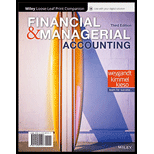
Concept explainers
(a)
Accounts receivable refers to the amounts to be received within a short period from customers upon the sale of goods and services on account. In other words, accounts receivable are amounts customers owe to the business. Accounts receivable is an asset of a business.
Bad debt expense:
Bad debt expense is an expense account. The amounts of loss incurred from extending credit to the customers are recorded as bad debt expense. In other words, the estimated uncollectible accounts receivable are known as bad debt expense.
Aging of receivables:
A method of determining the estimated uncollectible receivables based on the age of individual accounts receivable is known as aging of receivables method.
Allowance method:
It is a method for accounting bad debt expense, where amount of uncollectible accounts receivables are estimated and recorded at the end of particular period. Under this method,
Direct write-off method:
This method does not make allowance or estimation for uncollectible accounts, instead this method directly write-off the actual uncollectible accounts by debiting bad debt expense, and by crediting accounts receivable. Under this method, accounts would be written off only when the receivables from a customer remain uncollectible.
To identify: Whether Company D uses direct write-off method, or the allowance method for accounting bad debts.
(b)
To prepare: The
(c)
To prepare: The adjusting entry for recording the bad debt expenses at December 31, 2019.
(d)
To prepare: The
(e)
To prepare: The journal entry to write-off $3,000 of accounts receivable as uncollectible, under direct write-off method.
(f)
To identify: The type of account for allowance for doubtful accounts, and show how it affects accounts receivable reported on the balance sheet.
Want to see the full answer?
Check out a sample textbook solution
Chapter 8 Solutions
FINANCIAL&MNGRL ACCT (LL)W//WILEYPLUS>C
- Book value of an asset equals:A. Market valueB. Cost minus accumulated depreciationC. Net incomeD. Sale pricearrow_forwardPlease provide the correct answer to this financial accounting problem using accurate calculations.arrow_forwardBook value of an asset equals:A. Market valueB. Cost minus accumulated depreciationC. Net incomeD. Sale pricearrow_forward

 AccountingAccountingISBN:9781337272094Author:WARREN, Carl S., Reeve, James M., Duchac, Jonathan E.Publisher:Cengage Learning,
AccountingAccountingISBN:9781337272094Author:WARREN, Carl S., Reeve, James M., Duchac, Jonathan E.Publisher:Cengage Learning, Accounting Information SystemsAccountingISBN:9781337619202Author:Hall, James A.Publisher:Cengage Learning,
Accounting Information SystemsAccountingISBN:9781337619202Author:Hall, James A.Publisher:Cengage Learning, Horngren's Cost Accounting: A Managerial Emphasis...AccountingISBN:9780134475585Author:Srikant M. Datar, Madhav V. RajanPublisher:PEARSON
Horngren's Cost Accounting: A Managerial Emphasis...AccountingISBN:9780134475585Author:Srikant M. Datar, Madhav V. RajanPublisher:PEARSON Intermediate AccountingAccountingISBN:9781259722660Author:J. David Spiceland, Mark W. Nelson, Wayne M ThomasPublisher:McGraw-Hill Education
Intermediate AccountingAccountingISBN:9781259722660Author:J. David Spiceland, Mark W. Nelson, Wayne M ThomasPublisher:McGraw-Hill Education Financial and Managerial AccountingAccountingISBN:9781259726705Author:John J Wild, Ken W. Shaw, Barbara Chiappetta Fundamental Accounting PrinciplesPublisher:McGraw-Hill Education
Financial and Managerial AccountingAccountingISBN:9781259726705Author:John J Wild, Ken W. Shaw, Barbara Chiappetta Fundamental Accounting PrinciplesPublisher:McGraw-Hill Education





